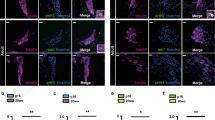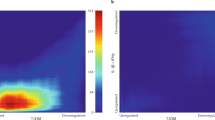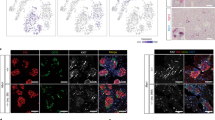Abstract
Replication of β cells is an important source of β-cell expansion in early childhood. The recent linkage of type 2 diabetes with several transcription factors involved in cell cycle regulation implies that growth of the β-cell mass in early childhood might be an important determinant of risk for type 2 diabetes. Under some circumstances, including obesity and pregnancy, the β-cell mass is adaptively increased in adult humans. The mechanisms by which this adaptive growth occurs and the relative contributions of β-cell replication or of mechanisms independent of β-cell replication are unknown. Also, although there is interest in the potential for β-cell regeneration as a therapeutic approach in both type 1 and 2 diabetes, little is yet known about the potential sources of new β cells in adult humans. In common with other cell types, replicating β cells have an increased vulnerability to apoptosis, which is likely to limit the therapeutic value of inducing β-cell replication in the proapoptotic environment of type 1 and 2 diabetes unless applied in conjunction with a strategy to suppress increased apoptosis.
Key Points
-
Replication of β-cells is important in growth of the β-cell mass during infancy in humans but is infrequent in adults, implying that most β cells are then quiescent
-
The β-cell mass increases in response to obesity and pregnancy in humans, implying some ongoing capacity for β-cell turnover but much less than that in rodents
-
The range of β-cell mass in nondiabetic humans far exceeds the adaptive increase in response to chronic insulin resistance, implying a wide range of growth in β-cell mass during infancy
-
Sources of new β cells that do not rely on β-cell replication have been proposed but are as yet unproven in humans
-
Newly forming β cells have an increased vulnerability to apoptosis, probably limiting potential β-cell regeneration
-
Although β-cell regeneration has been proposed as a therapy for type 1 and type 2 diabetes, neither the extent that β-cell regeneration can be accomplished nor the mechanisms involved have been established in humans
This is a preview of subscription content, access via your institution
Access options
Subscribe to this journal
Receive 12 print issues and online access
$209.00 per year
only $17.42 per issue
Buy this article
- Purchase on Springer Link
- Instant access to full article PDF
Prices may be subject to local taxes which are calculated during checkout





Similar content being viewed by others
References
Meier JJ and Butler PC (2005) Insulin secretion. In Endocrinology, edn 5, 961–973 (Eds DeGroot LJ and Jameson JL) Philadelphia: Elsevier Saunders
Stefan Y et al. (1982) Quantitation of endocrine cell content in the pancreas of nondiabetic and diabetic humans. Diabetes 31: 694–700
Service FJ (1999) Classification of hypoglycemic disorders. Endocrinol Metab Clin North Am 28: 501–517, vi
Stanger BZ et al. (2007) Organ size is limited by the number of embryonic progenitor cells in the pancreas but not the liver. Nature 445: 886–891
Georgia S et al. (2006) p57 and Hes1 coordinate cell cycle exit with self-renewal of pancreatic progenitors. Dev Biol 298: 22–31
Kassem SA et al. (2000) β-Cell proliferation and apoptosis in the developing normal human pancreas and in hyperinsulinism of infancy. Diabetes 49: 1325–1333
Dor Y et al. (2004) Adult pancreatic β-cells are formed by self-duplication rather than stem-cell differentiation. Nature 429: 41–46
Teta M et al. (2007) Growth and regeneration of adult β cells does not involve specialized progenitors. Dev Cell 12: 817–826
Rane SG et al. (1999) Loss of Cdk4 expression causes insulin-deficient diabetes and Cdk4 activation results in β-islet cell hyperplasia. Nat Genet 22: 44–52
Georgia S et al. (2004) β Cell replication is the primary mechanism for maintaining postnatal β cell mass. J Clin Invest 114: 963–968
Kushner JA et al. (2005) Cyclins D2 and D1 are essential for postnatal pancreatic β-cell growth. Mol Cell Biol 25: 3752–3762
Vasavada RC et al. (2007) Tissue-specific deletion of the retinoblastoma protein in the pancreatic β-cell has limited effects on β-cell replication, mass, and function. Diabetes 56: 57–64
Krishnamurthy J et al. (2006) p16INK4a induces an age-dependent decline in islet regenerative potential. Nature 443: 453–457
Uchida T et al. (2005) Deletion of Cdkn1b ameliorates hyperglycemia by maintaining compensatory hyperinsulinemia in diabetic mice. Nat Med 11: 175–182
Georgia S et al. (2006) p27 Regulates the transition of β-cells from quiescence to proliferation. Diabetes 55: 2950–2956
Karnik SK et al. (2005) Menin regulates pancreatic islet growth by promoting histone methylation and expression of genes encoding p27Kip1 and p18INK4c. Proc Natl Acad Sci USA 102: 14659–14664
Teta M et al. (2005) Very slow turnover of β-cells in aged adult mice. Diabetes 54: 2557–2567
Van Assche FA et al. (1978) A morphological study of the endocrine pancreas in human pregnancy. Br J Obstet Gynaecol 85: 818–820
Butler AE et al. (2003) β-Cell deficit and increased β-cell apoptosis in humans with type 2 diabetes. Diabetes 52: 102–110
Terauchi Y et al. (2007) Glucokinase and IRS-2 are required for compensatory β cell hyperplasia in response to high-fat diet-induced insulin resistance. J Clin Invest 117: 246–257
Okamoto H et al. (2006) Role of the forkhead protein FoxO1 in β cell compensation to insulin resistance. J Clin Invest 116: 775–782
Kulkarni RN et al. (2004) PDX-1 haploinsufficiency limits the compensatory islet hyperplasia that occurs in response to insulin resistance. J Clin Invest 114: 828–836
Gupta RK et al. (2007) Expansion of adult β-cell mass in response to increased metabolic demand is dependent on HNF-4α. Genes Dev 21: 756–769
Cozar-Castellano I et al. (2006) Molecular control of cell cycle progression in the pancreatic β-cell. Endocr Rev 27: 356–370
Bannigan J et al. (1979) The cellular effect of 5-bromodeoxyuridine on the mammalian embryo. J Embryol Exp Morphol 50: 123–135
Beisker W et al. (1988) Measurement of the kinetics of DNA repair synthesis after UV irradiation using immunochemical staining of incorporated 5-bromo-2'-deoxyuridine and flow cytometry. Exp Cell Res 174: 156–167
Endl E et al. (2000) The Ki-67 protein: fascinating forms and an unknown function. Exp Cell Res 257: 231–237
Zacchetti A et al. (2003) Validation of the use of proliferation markers in canine neoplastic and non-neoplastic tissues: comparison of KI-67 and proliferating cell nuclear antigen (PCNA) expression versus in vivo bromodeoxyuridine labelling by immunohistochemistry. APMIS 111: 430–438
Bullwinkel J et al. (2006) Ki-67 protein is associated with ribosomal RNA transcription in quiescent and proliferating cells. J Cell Physiol 206: 624–635
Hendzel MJ et al. (1997) Mitosis-specific phosphorylation of histone H3 initiates primarily within pericentromeric heterochromatin during G2 and spreads in an ordered fashion coincident with mitotic chromosome condensation. Chromosoma 106: 348–360
Butler AE et al. (2003) Increased β-cell apoptosis prevents adaptive increase in β-cell mass in mouse model of type 2 diabetes: evidence for role of islet amyloid formation rather than direct action of amyloid. Diabetes 52: 2304–2314
Ianus A et al. (2003) In vivo derivation of glucose-competent pancreatic endocrine cells from bone marrow without evidence of cell fusion. J Clin Invest 111: 843–850
Bonner-Weir S et al. (2002) Pancreatic stem cells. J Pathol 197: 519–526
Gershengorn MC et al. (2004) Epithelial-to-mesenchymal transition generates proliferative human islet precursor cells. Science 306: 2261–2264
Butler AE et al. (2007) Hematopoietic stem cells derived from adult donors are not a source of pancreatic β cells in adult nondiabetic humans. Diabetes 56: 1810–1806
Kayali AG et al. (2007) Limited capacity of human adult islets expanded in vitro to redifferentiate into insulin-producing β-cells. Diabetes 56: 703–708
Hess D et al. (2003) Bone marrow-derived stem cells initiate pancreatic regeneration. Nat Biotechnol 21: 763–770
Voltarelli JC et al. (2007) Autologous nonmyeloablative hematopoietic stem cell transplantation in newly diagnosed type 1 diabetes mellitus. JAMA 297: 1568–1576
Atkinson MA (2005) ADA Outstanding Scientific Achievement Lecture 2004. Thirty years of investigating the autoimmune basis for type 1 diabetes: why can't we prevent or reverse this disease? Diabetes 54: 1253–1263
Foulis AK et al. (1984) The pancreas in recent-onset type 1 (insulin-dependent) diabetes mellitus: insulin content of islets, insulitis and associated changes in the exocrine acinar tissue. Diabetologia 26: 456–461
Meier JJ et al. (2006) Increased islet β cell replication adjacent to intrapancreatic gastrinomas in humans. Diabetologia 49: 2689–2696
Meier JJ et al. (2005) Sustained β cell apoptosis in patients with long-standing type 1 diabetes: indirect evidence for islet regeneration? Diabetologia 48: 2221–2228
Sit KH et al. (1997) Transient G2M arrest and subsequent release of apoptotic and mitotic cells in vanadyl(4)-prepulsed human Chang liver cells. Cell Death Differ 4: 216–223
Webb SJ et al. (1997) Apoptosis: an overview of the process and its relevance in disease. Adv Pharmacol 41: 1–34
Ritzel RA et al. (2003) Replication increases β-cell vulnerability to human islet amyloid polypeptide-induced apoptosis. Diabetes 52: 1701–1708
Sladek R et al. (2007) A genome-wide association study identifies novel risk loci for type 2 diabetes. Nature 445: 881–885
Zeggini E et al. (2007) Replication of genome-wide association signals in UK samples reveals risk loci for type 2 diabetes. Science 316: 1336–1341
Scott LJ et al. (2007) A genome-wide association study of type 2 diabetes in Finns detects multiple susceptibility variants. Science 316: 1341–1345
Bort R et al. (2004) Hex homeobox gene-dependent tissue positioning is required for organogenesis of the ventral pancreas. Development 131: 797–806
Stickens D et al. (1996) The EXT2 multiple exostoses gene defines a family of putative tumour suppressor genes. Nat Genet 14: 25–32
Spagnoli FM et al. (2006) The RNA-binding protein, Vg1RBP, is required for pancreatic fate specification. Dev Biol 292: 442–456
Saxena R et al. (2006) Common single nucleotide polymorphisms in TCF7L2 are reproducibly associated with type 2 diabetes and reduce the insulin response to glucose in nondiabetic individuals. Diabetes 55: 2890–2895
Ubeda M et al. (2006) Inhibition of cyclin-dependent kinase 5 activity protects pancreatic β cells from glucotoxicity. J Biol Chem 281: 28858–28864
Ritzel RA et al. (2006) Relationship between β-cell mass and fasting blood glucose concentration in humans. Diabetes Care 29: 717–718
Barker DJ et al. (1993) Type 2 (non-insulin-dependent) diabetes mellitus, hypertension and hyperlipidaemia (syndrome X): relation to reduced fetal growth. Diabetologia 36: 62–67
de Rooij SR et al. (2006) Glucose tolerance at age 58 and the decline of glucose tolerance in comparison with age 50 in people prenatally exposed to the Dutch famine. Diabetologia 49: 637–643
Fakhrai-Rad H et al. (2000) Insulin-degrading enzyme identified as a candidate diabetes susceptibility gene in GK rats. Hum Mol Genet 9: 2149–2158
Nath DS et al. (2005) Outcomes of pancreas transplants for patients with type 2 diabetes mellitus. Clin Transplant 19: 792–797
Robertson RP et al. (1999) Normoglycemia and preserved insulin secretory reserve in diabetic patients 10-18 years after pancreas transplantation. Diabetes 48: 1737–1740
Bonner-Weir S et al. (1983) Partial pancreatectomy in the rat and subsequent defect in glucose-induced insulin release. J Clin Invest 71: 1544–1553
Bonner-Weir S (1994) Regulation of pancreatic β-cell mass in vivo. Recent Prog Horm Res 49: 91–104
Robertson RP et al. (2002) Relationship between diabetes and obesity 9 to 18 years after hemipancreatectomy and transplantation in donors and recipients. Transplantation 73: 736–741
Matveyenko AV et al. (2006) Mechanisms of impaired fasting glucose and glucose intolerance induced by an approximate 50% pancreatectomy. Diabetes 55: 2347–2356
Stagner JI et al. (1991) Deterioration of islet β-cell function after hemipancreatectomy in dogs. Diabetes 40: 1472–1479
Meier JJ et al. (2006) Direct evidence of attempted β cell regeneration in an 89-year-old patient with recent-onset type 1 diabetes. Diabetologia 49: 1838–1844
Meier JJ et al. (2006) The potential for stem cell therapy in diabetes. Pediatr Res 59: 65R–73R
Meier JJ et al. (2006) Increased vulnerability of newly forming β cells to cytokine-induced cell death. Diabetologia 49: 83–89
Herold KC et al. (2002) Anti-CD3 monoclonal antibody in new-onset type 1 diabetes mellitus. N Engl J Med 346: 1692–1698
Leslie RD (2004) Preventing type 1 diabetes mellitus: hype and hope. Clin Med 4: 442–446
Buchanan TA et al. (2002) Preservation of pancreatic β-cell function and prevention of type 2 diabetes by pharmacological treatment of insulin resistance in high-risk hispanic women. Diabetes 51: 2796–2803
Suarez-Pinzon WL et al. (2005) Combination therapy with epidermal growth factor and gastrin increases β-cell mass and reverses hyperglycemia in diabetic NOD mice. Diabetes 54: 2596–2601
Rhodes CJ (2000) IGF-I and GH post-receptor signaling mechanisms for pancreatic β-cell replication. J Mol Endocrinol 24: 303–311
Meier JJ et al. (2005) Glucagon-like peptide 1(GLP-1) in biology and pathology. Diabetes Metab Res Rev 21: 91–117
Marchetti P et al. (2004) Pancreatic islets from type 2 diabetic patients have functional defects and increased apoptosis that are ameliorated by metformin. J Clin Endocrinol Metab 89: 5535–5541
(1998) Effect of intensive blood-glucose control with metformin on complications in overweight patients with type 2 diabetes (UKPDS 34). UK Prospective Diabetes Study (UKPDS) Group. Lancet 352: 854–865
Kahn SE et al. (2006) Glycemic durability of rosiglitazone, metformin, or glyburide monotherapy. N Engl J Med 355: 2427–2443
Lin CY et al. (2005) Activation of peroxisome proliferator-activated receptor-γ by rosiglitazone protects human islet cells against human islet amyloid polypeptide toxicity by a phosphatidylinositol 3'-kinase-dependent pathway. J Clin Endocrinol Metab 90: 6678–6686
Nissen SE et al. (2007) Effect of rosiglitazone on the risk of myocardial infarction and death from cardiovascular causes. N Engl J Med 356: 2457–2471
Matthews DR et al. (1998) UKPDS 26: Sulphonylurea failure in non-insulin-dependent diabetic patients over six years. UK Prospective Diabetes Study (UKPDS) Group. Diabet Med 15: 297–303
Maedler K et al. (2005) Sulfonylurea induced β-cell apoptosis in cultured human islets. J Clin Endocrinol Metab 90: 501–506
Lupi R et al. (2006) The direct effects of the angiotensin-converting enzyme inhibitors, zofenoprilat and enalaprilat, on isolated human pancreatic islets. Eur J Endocrinol 154: 355–361
Bosch J et al. (2006) Effect of ramipril on the incidence of diabetes. N Engl J Med 355: 1551–1562
Kjems LL et al. (2001) Decrease in β-cell mass leads to impaired pulsatile insulin secretion, reduced postprandial hepatic insulin clearance, and relative hyperglucagonemia in the minipig. Diabetes 50: 2001–2012
Matveyenko AV et al. (2006) β-Cell deficit due to increased apoptosis in the human islet amyloid polypeptide transgenic (HIP) rat recapitulates the metabolic defects present in type 2 diabetes. Diabetes 55: 2106–2114
Author information
Authors and Affiliations
Corresponding author
Ethics declarations
Competing interests
PC Butler has received investigator-initiated research grant funding from Merck, Novo Nordisk and Pfizer. The other authors declared no competing interests.
Rights and permissions
About this article
Cite this article
Butler, P., Meier, J., Butler, A. et al. The replication of β cells in normal physiology, in disease and for therapy. Nat Rev Endocrinol 3, 758–768 (2007). https://doi.org/10.1038/ncpendmet0647
Received:
Accepted:
Issue Date:
DOI: https://doi.org/10.1038/ncpendmet0647
This article is cited by
-
Hepatic non-parenchymal S100A9-TLR4-mTORC1 axis normalizes diabetic ketogenesis
Nature Communications (2022)
-
Improvement of the therapeutic capacity of insulin-producing cells trans-differentiated from human liver cells using engineered cell sheet
Stem Cell Research & Therapy (2021)
-
Evolution of endodontic medicine: a critical narrative review of the interrelationship between endodontics and systemic pathological conditions
Odontology (2021)
-
Glutathione prevents chronic oscillating glucose intake-induced β-cell dedifferentiation and failure
Cell Death & Disease (2019)
-
S100A9 extends lifespan in insulin deficiency
Nature Communications (2019)



